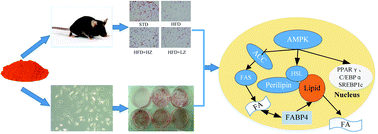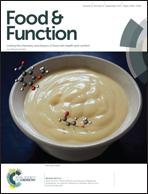Anti-obesity effects of zeaxanthin on 3T3-L1 preadipocyte and high fat induced obese mice†
Abstract
Zeaxanthin, a type of carotenoid, has been proven to exhibit anti-lipogenesis effect; however, the detailed mechanism of this effect is less known. Herein, we evaluated the effects of zeaxanthin on the inhibition of adipogenesis in 3T3-L1 adipocytes and obesity in high-fat diet fed C57BL/6J mice. Zeaxanthin significantly decreased the intracellular lipid content in a dose-dependent manner (5–15 μM) in adipocytes without causing cytotoxicity. In high-fat-diet-induced obese mice, oral administration of 20 mg kg−1 zeaxanthin attenuated the progression of obesity and improved dyslipidemia. It exhibits an anti-adipogenic effect via down-regulating the transcriptional factors and adipocyte-specific genes involved in adipogenesis, both in vitro and in vivo. Furthermore, zeaxanthin treatment reversed the MDI (0.5 mM 3-isobutyl-1-methylxanthine, 1.0 μM dexamethasone, and 1.0 μg mL−1 insulin) and HFD (high-fat diet)-induced inhibition of AMPK phosphorylation in adipocytes and epididymal adipose tissues, respectively, thereby modulating the energy metabolism. These results indicated that zeaxanthin plays anti-adipogenic and anti-obesity roles by inducing AMPK activation, inhibiting lipogenesis, and decreasing intracellular lipid content, adipocyte size, and adipose weight.



 Please wait while we load your content...
Please wait while we load your content...